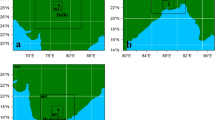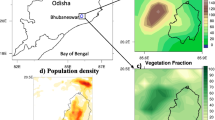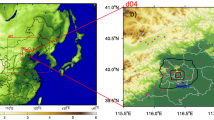Abstract
Numerical modeling of urban climate is essential for understanding mechanisms of the urban heat island (UHI) phenomenon. However, models must first be evaluated to identify their limitations. Over India, the evaluation of the Weather Research and Forecasting (WRF) model is limited. Here, WRF was evaluated over Bengaluru, India diurnally during the dry and wet seasons. Simulations were performed for cases using no urban canopy model (No-UCM), the single-layer UCM (SLUCM), and the multi-layer UCM (MLUCM) with the Mellor-Yamada-Janjić and the Bougeault and Lacarrerè planetary boundary layer (PBL) schemes. The simulations were compared to land surface temperature (LST) observations from the Moderate Resolution Imaging Spectroradiometer for their biases in urban LST, non-urban LST, and UHI intensity. Absorbed shortwave radiation, net longwave radiation, sensible heat, and latent heat were investigated for their possible role in driving the LST biases since they are calculated differently depending on which UCM is used. Results show urban LST was more sensitive to UCM choice than PBL scheme and the use of an UCM reduced urban LST biases, leading to improved simulations of the UHI. Non-urban LST was insensitive to UCM and PBL choice. For the best case, urban LST was underestimated by less than 1 °C during the dry season day and night, and was overestimated by 1.88 °C and 0.08 °C in the wet season day and night. In general, the SLUCM had the least bias for urban LST and UHI intensity due to a near-zero latent heat flux in No-UCM, too much trapping of shortwave and longwave radiation by the MLUCM during daytime, and too much surface cooling at nighttime by the MLUCM. These results can inform future WRF studies that evaluate UHI mitigation strategies over Bengaluru on the best model physics to use.










Similar content being viewed by others
Data availability
The MODIS Terra and Aqua combined land cover dataset is available from https://e4ftl01.cr.usgs.gov/MOTA/MCD12Q2.006/2018.01.01/. The MODIS LST dataset is available from https://e4ftl01.cr.usgs.gov/MOLT/MOD11A2.061/ for Terra and https://e4ftl01.cr.usgs.gov/MOLA/MYD11A2.061/ for Aqua. The ERA5 reanalysis data is available from https://cds.climate.copernicus.eu/cdsapp#!/dataset/reanalysis-era5-pressure-levels?tab=overview for pressure level data and https://cds.climate.copernicus.eu/cdsapp#!/dataset/reanalysis-era5-single-levels?tab=overview for surface data. The WRF model can be downloaded from https://www.mmm.ucar.edu/models/wrf. The simulations presented in this study can be made available by contacting Heather Sussman (Heather.S.Sussman@usace.army.mil).
Code availability
All analyses and figure creations were carried out in MATLAB by MathWorks (https://www.mathworks.com/products/matlab.html). Code used for this study can be made available by contacting Heather Sussman (Heather.S.Sussman@usace.army.mil).
References
Ackerman SA, Holz RE, Frey R et al (2008) Cloud detection with MODIS. Part II: validation. J Atmos Ocean Technol 25:1073–1086. https://doi.org/10.1175/2007JTECHA1053.1
Ajilesh P, Rakesh V, Sahoo SK, Himesh S (2019) Observed and model-simulated thermodynamic processes associated with urban heavy rainfall events over Bangalore, India. Meteorol Appl 27:e1854. https://doi.org/10.1002/met.1854
Andersson E (2006) Urban landscapes and sustainable cities. Ecol Soc 11:34. https://doi.org/10.5751/ES-01639-110134
Banks RF, Tiana-Alsina J, Rocadenbosch F, Baldasano JM (2015) Performance evaluation of the boundary-layer height from Lidar and the weather research and forecasting model at an urban coastal site in the north-East Iberian Peninsula. Bound-Layer Meteorol 157:265–292. https://doi.org/10.1007/s10546-015-0056-2
Belward AS, Estes JE, Kilne KD (1999) The IGBP-DIS global 1-km land-cover data set DISCover: a project overview. Photogramm Eng Remote Sensing 65:1013–1020
Bhati S, Mohan M (2018) WRF-urban canopy model evaluation for the assessment of heat island and thermal comfort over an urban airshed in India under varying land use/land cover conditions. Geosci Lett 5:27. https://doi.org/10.1186/s40562-018-0126-7
Bougeault P, Lacarrerè P (1989) Parameterization of orography-induced turbulence in a mesobeta-scale model. Mon Weather Rev 117:1872–1890. https://doi.org/10.1175/1520-0493(1989)117%3C1872:POOITI%3E2.0.CO;2
Büttner G, Feranec J, Jaffrin G et al (2004) The CORINE land cover 2000 project. R. Reuter (Ed.), EARSeL eProceedings, Vol. 3, EARSeL, Paris, pp. 331–346
Chen F, Dudhia J (2001) Coupling an advanced land surface-hydrology model with the Penn State–NCAR MM5 modeling system. Part 1: model implementation and sensitivity. Mon Weather Rev 129:569–585. https://doi.org/10.1175/1520-0493(2001)129%3C0569:CAALSH%3E2.0.CO;2
Chen F, Kusaka H, Bornstein R et al (2011) The integrated WRF/urban modelling system: development, evaluation, and applications to urban environmental problems. Int J Climatol 31:273–288. https://doi.org/10.1002/joc.2158
Ching J, Mills G, Bechtel B et al (2018) World Urban Database and Access Portal Tools (WUDAPT), an urban weather, climate and environmental modeling infrastructure for the Anthropocene. Bull Am Meteorol Soc 99:1907–1924. https://doi.org/10.1175/BAMS-D-16-0236.1
Dai A, Trenberth KE, Karl TR (1999) Effects of clouds, soil moisture, precipitation and water vapor on diurnal temperature range. J Clim 12:2451–2473. https://doi.org/10.1175/1520-0442(1999)012%3C2451:EOCSMP%3E2.0.CO;2
Dudhia J (1989) Numerical study of convection observed during the Winter Monsoon Experiment using a mesoscale two-dimensional model. J Atmos Sci 46:3077–3107. https://doi.org/10.1175/1520-0469(1989)046%3c3077:NSOCOD%3e2.0.CO;2
Ferrero E, Alessandrini S, Vandenberghe F (2018) Assessment of planetary-boundary-layer schemes in the weather research and forecasting model within and above an urban canopy layer. Bound-Layer Meteorol 168:289–319. https://doi.org/10.1007/s10546-018-0349-3
Filho WL, Icaza LE, Neht A et al (2018) Coping with the impacts of urban heat islands. A literature based study on understanding urban heat vulnerability and the need for resilience in cities in a global climate change context. J Clean Prod 171:1140–1149. https://doi.org/10.1016/j.jclepro.2017.10.086
Garratt JR (1994) Review: the atmospheric boundary layer. Earth Sci Rev 37:89–134. https://doi.org/10.1016/0012-8252(94)90026-4
Grimm NB, Faeth SH, Golubiewski NE et al (2008) Global change and the ecology of cities. Science 319:756–760. https://doi.org/10.1126/science.1150195
Hersbach H, Bell B, Berrisford P et al (2020) The ERA5 global reanalysis. Q J R Meteorol Soc 146:1999–2049. https://doi.org/10.1002/qj.3803
Homer C, Dewitz J, Yang L et al (2015) Completion of the 2011 National Land Cover Database for the conterminous United States-Representing a decade of land cover change information. Photogramm Eng Remote Sens 81:345–354
Hung T, Uchihama D, Ochi S, Yasuoka Y (2005) Assessment with satellite data of the urban heat island effects in Asian mega cities. Int J Appl Earth Obs 8:34–48. https://doi.org/10.1016/j.jag.2005.05.003
Imran HM, Kala J, Ng AWM, Muthukumaran S (2018) Effectiveness of green and cool roofs in mitigating urban heat island effects during a heatwave event in the city of Melbourne in southeast Australia. J Clean Prod 197:393–405. https://doi.org/10.1016/j.jclepro.2018.06.179
Jandaghian Z, Beradi U (2020) Comparing urban canopy models for microclimate simulations in weather research and forecasting models. Sustain Cities Soc 55:102025. https://doi.org/10.1016/j.scs.2020.102025
Janjić ZI (1994) The step-mountain Eta coordinate model: further developments of the convection, viscous sublayer and turbulence closure schemes. Mon Wea Rev 122:927–945. https://doi.org/10.1175/1520-0493(1994)122%3C0927:TSMECM%3E2.0.CO;2
Janjić ZI (2002) Nonsingular implementation of the Mellor-Yamada level 2.5 scheme in the NCEP Meso model. In: NCEP Office Note, 437, p. 61. https://www.emc.ncep.noaa.gov/officenotes/newernotes/on437.pdf. Accessed 22 Feb 2022
Kedia S, Bhakare SP, Dwivedi AK et al (2021) Estimates of change in surface meteorology and urban heat island over northwest India: impact of urbanization. Urban Clim 36:100782. https://doi.org/10.1016/j.uclim.2021.100782
Kishtawal CM, Niyogi D, Tewari M et al (2010) Urbanization signature in the observed heavy rainfall climatology over India. Int J Climatol 30:1908–1916. https://doi.org/10.1002/joc.2044
Kusaka H, Kimura F (2004) Coupling a single-layer urban canopy model with a simple atmospheric model: impact on urban heat island simulation for an idealized case. J Meteorol Soc Japan 82:67–80. https://doi.org/10.2151/jmsj.82.67
Kusaka H, Kondo Y, Kikegawa Y, Kimura F (2001) A simple single-layer urban canopy model for atmospheric models: comparison with multi-layer and slab models. Bound-Layer Meteorol 101:329–358. https://doi.org/10.1023/A:1019207923078
Kwok YT, Ng EYY (2021) Trends, topics, and lessons learnt from real case studies using mesoscale atmospheric models for urban climate applications in 2000–2019. Urban Clim 36:100785. https://doi.org/10.1016/j.uclim.2021.100785
Lenzhöler S, Van der Wulp NY (2010) Thermal experience and perception of the built environment in Dutch urban squares. J Urban Des 15:375–401. https://doi.org/10.1080/13574809.2010.488030
Liu Y, Chen F, Warner T, Basara J (2006) Verification of a mesoscale data-assimilation and forecasting system for the Oklahoma City area during the Joint Urban 2003 Field Project. J Appl Meteorol Climatol 45:912–929. https://doi.org/10.1175/JAM2383.1
Liu C, Ikeda K, Rasmussen R et al (2017) Continental-scale convection-permitting modeling of the current and future climate of North America. Clim Dyn 49:71–95. https://doi.org/10.1007/s00382-016-3327-9
Martilli A, Clappier A, Rotach MW (2002) An urban surface exchange parameterization for mesoscale models. Bound Layer Meteorol 104:261–304. https://doi.org/10.1023/A:1016099921195
Mlawer EJ, Taubman SJ, Brown PD et al (1997) Radiative transfer for inhomogeneous atmospheres: RRTM, a validated correlated–k model for the longwave. J Geophys Res 102:16663–16682. https://doi.org/10.1029/97JD00237
Mohan M, Sati AP, Bhati S (2020) Urban sprawl during five decadal period over National Capital Region of India: impact on urban heat island and thermal comfort. Urban Clim 33:100647. https://doi.org/10.1016/j.uclim.2020.100647
Morini E, Touchaei AG, Rossi F et al (2018) Evaluation of albedo enhancement to mitigate impacts of urban heat island in Rome (Italy) using WRF meteorological model. Urban Clim 24:551–566. https://doi.org/10.1016/j.uclim.2017.08.001
Oke TR (1982) The energetic basis of the urban heat island. Q J R Meteorol Soc 108:1–24
Parthasarathy B (1984) Interannual and long-term variability of Indian summer monsoon rainfall. Proc Indian Acad Sci (earth Planet Sci) 93:371–385. https://doi.org/10.1007/BF02843255
Patel P, Karmakar S, Ghosh S, Niyogi D (2020) Improved simulation of very heavy rainfall events by incorporating WUDAPT urban land use/land cover in WRF. Urban Clim 32:100616. https://doi.org/10.1016/j.uclim.2020.100616
Paul S, Ghosh S, Mathew M et al (2018) Increased spatial variability and intensification of extreme monsoon rainfall due to urbanization. Sci Rep 8:3918. https://doi.org/10.1038/s41598-018-22322-9
Rakesh V, Mohapatra GN, Bankar A (2021) Historical extreme rainfall over the Bangalore city, India, on 14 and 15 August 2017: skill of sub-kilometer forecasts from WRF model. Meteorol Atmos Phys 133:1057–1074. https://doi.org/10.1007/s00703-021-00794-1
Ramachandran S, Kedia S, Srivastava R (2012) Aerosol optical depth trends over different regions of India. Atmos Environ 49:338–347. https://doi.org/10.1016/j.atmosenv.2011.11.017
Sahoo SK, Himesh S, Gouda KC (2020) Impact of urbanization on heavy rainfall events: a case study over the megacity of Bengaluru, India. Pure Appl Geophys 177:6029–6049. https://doi.org/10.1007/s00024-020-02624-8
Salamanca F, Martilli A (2010) A new building energy model coupled with an urban canopy parameterization for urban climate simulations—Part II. Validation with one dimension off-line simulations. Theor Appl Climatol 99:345–356. https://doi.org/10.1007/s00704-009-0142-9
Salamanca F, Martilli A, Tewari M, Chen F (2011) A study of the urban boundary layer using different urban parameterizations and high-resolution urban canopy parameters with WRF. J Appl Meteorol Climatol 50:1107–1128. https://doi.org/10.1175/2010JAMC2538.1
Sati AP, Mohan M (2018) The impact of urbanization during half a century on surface meteorology based on WRF model simulations over National Capital Region, India. Theor Appl Climatol 134:309–323. https://doi.org/10.1007/s00704-017-2275-6
Segura R, Badia A, Venture S et al (2021) Sensitivity study of PBL schemes and soil initialization using the WRF-BEP-BEM model over a Mediterranean coastal city. Urban Clim 39:100982. https://doi.org/10.1016/j.uclim.2021.100982
Shastri H, Paul S, Ghosh S, Karmakar S (2015) Impacts of urbanization on Indian summer monsoon rainfall extremes. J Geophys Res Atmos 120:495–516. https://doi.org/10.1002/2014JD022061
Skamarock WC, Klemp JB, Dudhia J et al (2019) A description of the advanced research WRF version 4. In: NCAR Technical Notes, pp. 145. https://opensky.ucar.edu/islandora/object/opensky%3A2898. Accessed 20 Feb 2022
Sohrabinia M, Rack W, Zawar-Reza P (2012) Analysis of MODIS LST compared with WRF model and in situ data over the Waimakariri River Basin, Canterbury, New Zealand. Remote Sens 4:3501–3527. https://doi.org/10.3390/rs4113501
Sudhira HS, Ramachandra TV, Bala Subrahmanya MH (2007) City profile: Bangalore. Cities 24:379–390. https://doi.org/10.1016/j.cities.2007.04.003
Sussman HS, Raghavendra A, Zhou L (2019) Impacts of increased urbanization on surface temperature, vegetation, and aerosols over Bengaluru, India. Remote Sens Appl Soc Environ 16:100261. https://doi.org/10.1016/j.rsase.2019.100261
Sussman HS, Dai A, Roundy PE (2021) The controlling factors of urban heat in Bengaluru, India. Urban Clim 38:100881. https://doi.org/10.1016/j.uclim.2021.100881
Taha H (1997) Urban climates and heat islands: albedo, evapotranspiration, and anthropogenic heat. Energ Buildings 25:99–103. https://doi.org/10.1016/S0378-7788(96)00999-1
Thompson G, Field PR, Rasmussen RM, Hall WD (2008) Explicit forecasts of winter precipitation using an improved bulk microphysics scheme. Part II: implementation of a new snow parameterization. Mon Weather Rev 136:5095–5115. https://doi.org/10.1175/2008MWR2387.1
van den Berg M, Wendel-Vos W, van Poppel M et al (2015) Health benefits of green spaces in the living environment: a systematic review of epidemiological studies. Urban for Urban Green 14:806–816. https://doi.org/10.1016/j.ufug.2015.07.008
Veena K, Parammasivam KM, Venkatesh TN (2020) Urban heat island studies: current status in India and a comparison with the international studies. J Earth Syst Sci 129:85. https://doi.org/10.1007/s12040-020-1351-y
Wan Z (2013) Collection-6 MODIS land surface temperature products users’ guide. pp. 33. https://lpdaac.usgs.gov/documents/118/MOD11_User_Guide_V6.pdf. Accessed 22 Feb 2022
Xia G, Cervarich MC, Baidya Roy S et al (2017) Simulating impacts of real-world wind farms on land surface temperature using the WRF model: validation with observations. Mon Weather Rev 145:4813–4836. https://doi.org/10.1175/MWR-D-16-0401.1
Xie B, Fund CH, Chan A, Lau A (2012) Evaluation of nonlocal and local planetary boundary layer schemes in the WRF model. J Geophys Res 117:D12103. https://doi.org/10.1029/2011JD017080
Zhou L, Dickinson RE, Tian Y et al (2004) Evidence for a significant urbanization effect on climate in China. Proc Natl Acad Sci USA 101:9540–9544. https://doi.org/10.1073/pnas.0400357101
Zhou L, Tian Y, Baidya Roy S et al (2012) Impacts of wind farms on land surface temperature. Nat Clim Change 2:539–543. https://doi.org/10.1038/nclimate1505
Funding
The research effort of HS is supported by the Science, Mathematics, and Research for Transformation (SMART) fellowship from the Department of Defense. AD acknowledges funding support from the National Science Foundation (grant nos. AGS-1353740 and OISE-1743738). LZ acknowledges funding support from the National Science Foundation (grant nos. AGS-1952745 and AGS-1854486).
Author information
Authors and Affiliations
Contributions
HS conceptualized the study. HS and AR performed the simulations and initial discussion of results. AD and LZ helped refine the methods. HS performed the calculations, made the figures, and wrote the first draft of this manuscript. AD, AR, and LZ helped revise this manuscript and provided feedback.
Corresponding author
Ethics declarations
Conflict of interest
On behalf of all authors, the corresponding author states that there is no conflict of interest.
Additional information
Publisher's Note
Springer Nature remains neutral with regard to jurisdictional claims in published maps and institutional affiliations.
Rights and permissions
About this article
Cite this article
Sussman, H.S., Dai, A., Raghavendra, A. et al. An evaluation of WRF urban canopy models over Bengaluru, India. Model. Earth Syst. Environ. 10, 1783–1802 (2024). https://doi.org/10.1007/s40808-023-01858-4
Received:
Accepted:
Published:
Issue Date:
DOI: https://doi.org/10.1007/s40808-023-01858-4




